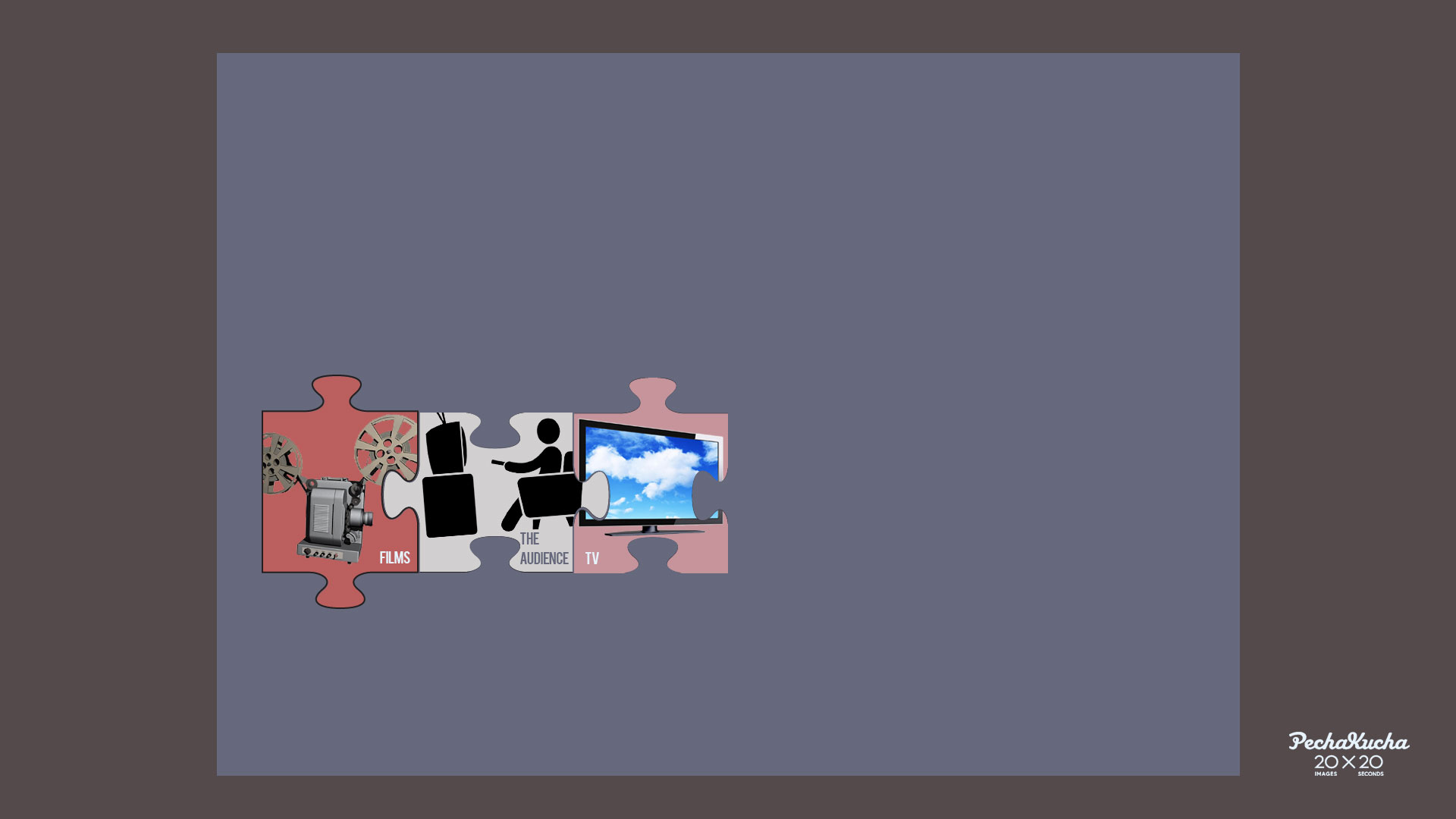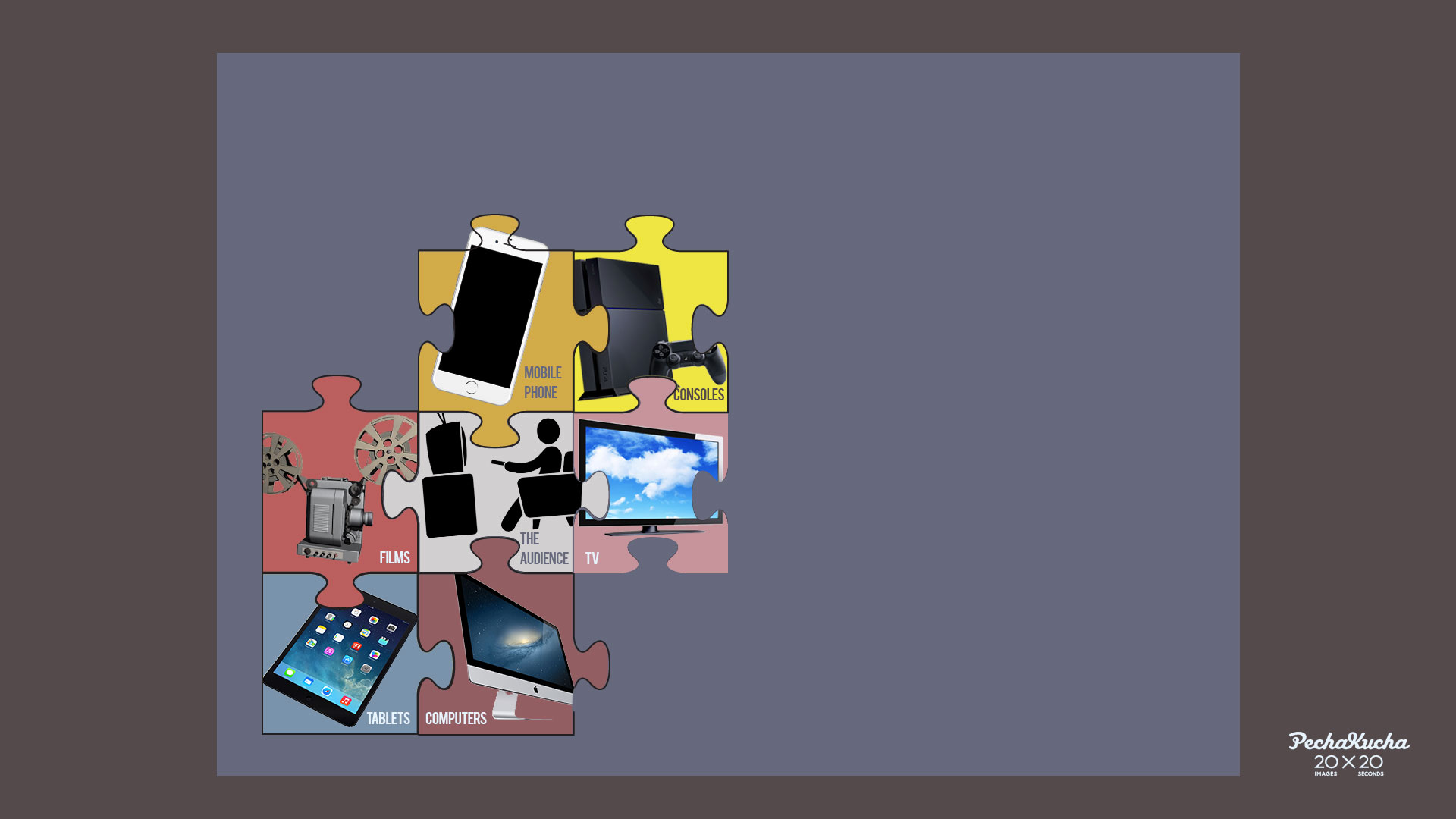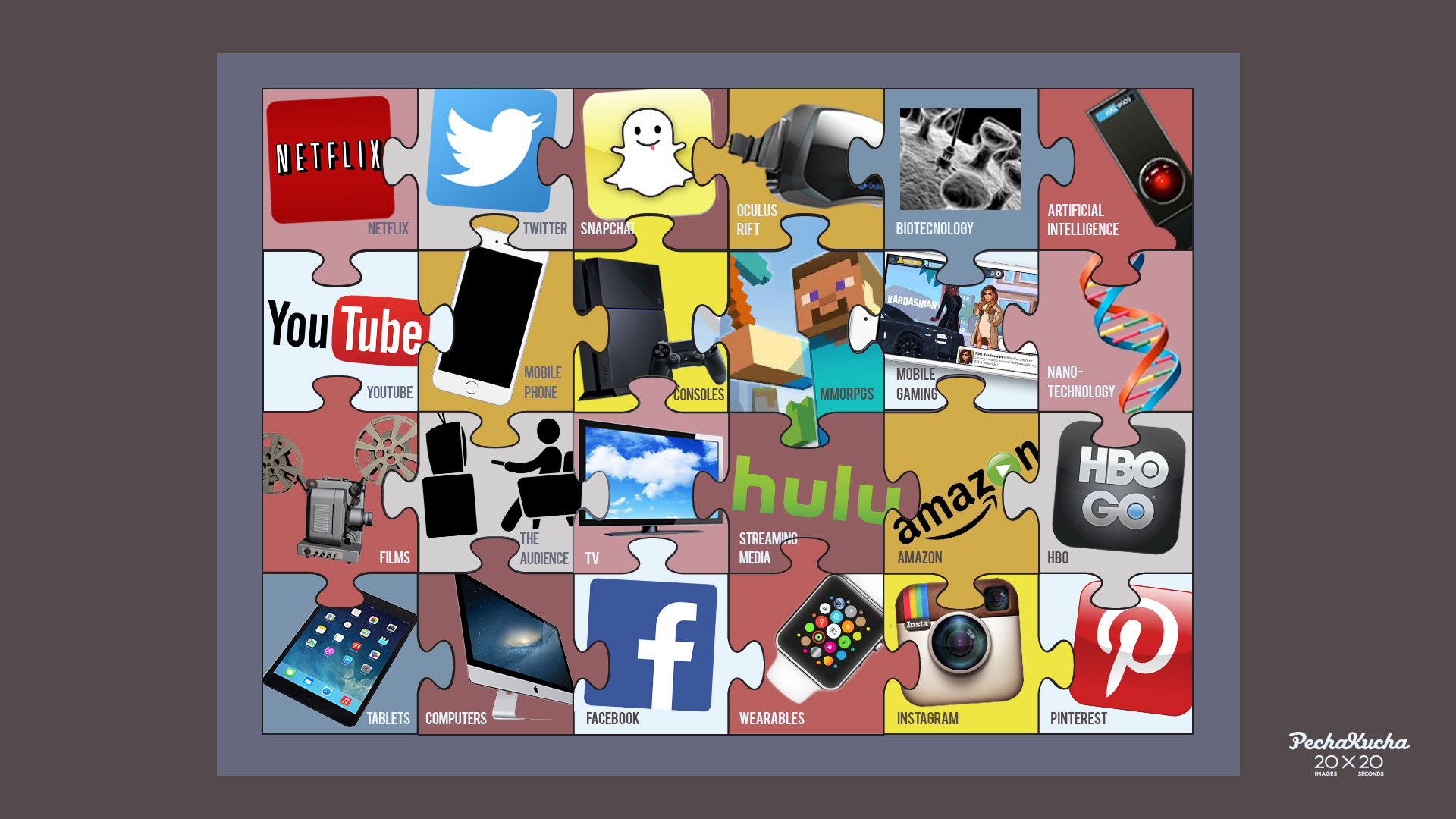This is a Pecha Kucha project I made in 2015 about the state of the entertainment industry (and beyond), and where I think it's all going. So far it's been EERILY accurate. The Pecha Kucha format means that it's supposed to be 20 slides which get shown for 20 seconds each. I took a few liberties with that format for this web presentation, expanding some slides to fill in some extra information. But I can give you a proper Pecha Kucha presentation in an interview format, just contact me about it.
I keep hearing (and using) the same phrase: “because 2015”. As in, “I have a pretty great résumé, but now you need a website because 2015”. Or “If you want to make something, you used to have to pitch to a network, but now you make it yourself because 2015.” Or “My 3 year old is trying to swipe while looking at pictures in magazines because 2015”.
It made me think of this article I read about the future of artificial intelligence that asked what it would be like to stand on the exponential curve of human progress over time. We can see it’s an exponential curve (based on things like Moore’s Law saying computers double in power every two years), but since we can’t see into the future, we miss the sudden seismic changes about to occur. Not taking into account the exponential level of progress makes us bad at predicting the future.
We tend to base our view of what’s going to happen in the future on our experience of what happened in the past or what is happening right now. We don’t see the giant exponential curve in front of us. And what stuck in my head was this idea of standing on an exponential curve and not seeing what’s in front of you, because it occurred to me that I HAD stood on an exponential curve and experienced this feeling: in Tokyo’s Fuji-Q amusement park, on a roller coaster called Dodonpa.
I rode it in 2007 with my wife. It currently ranks as the fourth fastest coaster in the world, but has the “fastest acceleration” because it launches with compressed air. The most special thing about Dodonpa, however, is its simplicity: no corkscrews or loop-de-loops, just straight track to pick up speed, and then you hit one giant 17 story hill. And there’s no conveyer belt “CHK-CHK-CHK” section when you go up, you just shoot into it and then drop from higher than you thought possible.
This is what it looks like just before you hit that 17-story exponential curve on Dodonpa. You can barely see it going up on the top of the screen there. You’re going so fast you don’t have time to really take in what’s about to happen. This is what this moment in 2015 feels like: we’re about to hit a giant exponential curve, and I don’t think people are looking far enough into the future to see it coming. On the other side of the curve there’s one of those high speed cameras that catch your face as you go by so they can sell you a photo on the way out.
Here’s what that photo looked like for us. You can see me there, scared out of my wits but enjoying it, two Japanese kids happily flashing peace signs behind us, and my wife next to me not taking it so well. It was very much like a wet cat: Just her looking at the camera with utter contempt and hatred for having to go through what she just went through.
And that’s what I think the danger is here approaching this exponential curve: if you’re not prepared to ride this thing, you’re not going to have a good time when it’s all over.
Now, an exponential curve might look linear, but in reality the futurist Ray Kurzweil describes it as more like a chain of letter S’s. There’s a period of slow growth as people develop new technology, then a period of rapid growth as that technology spreads and becomes embraced, and then a leveling off as people become used to and improve the new technology. We can zoom into the yellow section right here and see an S-curve close up.
For example, 1995 to 2007 was a rapid growth section - it saw the explosion of the internet, the introduction of Google, Youtube, and Facebook, the birth of social networking, and the introduction of cell phones AND smart phones. 2008 to 2015 has been less groundbreaking, at least on the technological front. But we’re about to hit something big, especially in the field of entertainment, which was previously the domain ruled by television and movies.
Now “entertainment” is much more broadly defined as “content”, and it includes social network updates, tweets, video games, anything that can take the attention of an audience. Now kids and millennials consume content on the web, over consoles, on tablets, and especially on mobile phones, because 2015. And on the horizon are known knowns (like wearables), and known unknowns (like artificial intelligence). To connect, content providers must find out what their audience loves and be ready to deliver it over as many platforms as possible.
So what do Millennials love? For Millennials, sharing a sense of humor trumps everything else in choosing their friends – more than taste in music, sports, or politics. But sense of humor isn’t one size fits all: Generation Y has a vastly different sense of humor than Generation X, and Generation Z are different than both of them. It’s a little tricky to gauge Generation Z’s sense of humor as they’re just turning 18, but we do know they are way more platform agnostic than any generation before them. And everyone loves to laugh.
So here’s an idea: Funny video games. This looks like a lot of games, but this is pretty much EVERY funny video game made since 1986. Basically, there were a few stabs at the form in the 80’s and 90’s from four main companies, but overall, the technology wasn’t there to deliver the kind of timing and responsiveness that humor required. Things like horror and action just translated over to video games more easily. But in the past two years, the technology has finally caught up to where it needs to be to allow for true comedy like South Park: The Stick of Truth.
And funny video games can’t come quickly enough. People check their phones 150 times a day, each time getting some content off snapchat or the web or YouTube, because 2015. But what they do more than anything else during that time is play mobile games – almost one out of every three times. What I was trying to do at Comedy Central was push us into a new world of thinking about comedy content as more than just shows, but also games, microcontent, social interaction, and other innovative formats.
Gaming and “gamification” (the act of making something people already do into a game) can mix well with comedy. It’s the kind of thing @midnight does with its perpetually trending Hashtag Wars, and it was the kind of thing I was trying to do with plans for an @midnight mobile game. I wanted to gamify surfing the web, and let people score points for correctly predicting what would be behind the clickbait. By putting it in the context of a game, the expectation immediately becomes more interactive, and with a community of players it becomes way more social.
People really respond to Gamification – Almost 9 of 10 respondents in one survey said it would help them with eLearning apps. Wearables like fitbits and the applewatch do a great job of making physical fitness into a game, using FOMO to battle FOWO (Fear Of Working Out). Combining the interactivity of gamification with the broad appeal of humor could lead to big things: apps with personality, a virtual friend to play with you and make you laugh. I think this could be especially powerful for wearables.
Wearables are 100% happening, even if not everyone has them yet. The same is true for 3D printing, like this incredible 3D printed robotic dress. The future is already here, it’s just not evenly distributed. Content creators need to look at a world where distributing items will be as easy as sending out a recipe and figure out what content in that medium looks like, because 2015. They need to envision items that use new technology and think how they can give those “enchanted objects” a soul.
Speaking of enchanted objects, there’s a huge enchanted object about to come to market, and it’s going to take escapism to a whole new level of immersion. But it’s going to need people to come up with content for it. An Oculus Rift MMORPG, immersive narrative storytelling, and avatar-based social networking are tremendously exciting concepts about to be possible. From what I can tell about kids and millennials and their ability to juggle separate identities, it’s going to have a willing audience looking for just that kind of experience.
Millennials are defined by 4 M’s (Multiethnic Multicultural Multitaskers with Multiple identities) and this is even more pronounced in Generation Z. Together they’re also way more empathic, connected, and media-savvy than any generation ever. This curve we’re about to hit will play into their strengths. If you want to connect with them, you’re going to have to understand them. You have to know “why snapchat?” and what to hashtag and how much weight to give YouTube comments.
You’re going to have to be able to penetrate the white noise of a million content options. One way to do that: Microcontent. I did these in 2006 as part of a podbusting experiment to use DVR-blocking "brandmines" to make commercial breaks more unpredictable while delivering some sponsor integration. The idea was that in the middle of a commercial break something like this would play:
Quick, unexpected, branded, funny. That was the thinking.
Sometimes the old ways work. I’m a big fan of the Jay Ward “Rocky and Bullwinkle” serialized form of storytelling, and I think it would be easily adapted to the new landscape. I also love the old way shows used to shill products, and I see a clear line between that and the podcast model of advertising today. It feels more honest and like content of its own, and it takes advantage of word of mouth being far more powerful than marketing. But you’re also going to need to innovate if you want to stay ahead of this curve.
It’s impossible to do it alone. It’s going to require teams of people working together as one. You’ll need maestros, not just virtuosos, and the process is as important as the product. One thing I used was Police Chief meetings. Everyone needed to be looped in, but they all had their own tight schedules and no free time. But everyone has 15 minutes they can spare. Start and end promptly. No chairs. Status report, next steps, quick discussion. It’s a more focused, disciplined, and actionable way to maintain unity.
Okay, summing up. Let me tell you about Madagascar. The Malagasy people there see the future as unknowable. We see ourselves at the present, with the past behind us and the future ahead of us, but the Malagasy see themselves as being dragged backwards into the future: they look back into the past, but what lies ahead of them is so inherently unpredictable that to plan for anything is folly. So stores and gas stations don’t restock until their entire inventory is gone, and planes and busses don’t follow a schedule but instead leave when they’re full.
The future is not going to be written by the Malagasy, but it’s going to effect them. They’re going to be pulled up this curve with everyone else, and on the other side of that curve they’re going to look like a wet cat. So are people who don’t see that this curve is exponential, they’re going to be getting ready for a future that is several steps below where we’re going. The future IS knowable. You just need the vision to see it and the courage to embrace it. Because “Because 2015” will soon be “Because 2020”, and I want to be prepared for that moment.
SOURCES
Cover image: Chris Ware’s “Playdate” cover for the New Yorker, June 15th, 2015.
Slides 2, 3, 7, 8 adapted from Tim Urban's article on Artificial Intelligence on his site Wait But Why.
Dodonpa images from Google Image search.
Wet cat image from the internet, home of SO MANY cat images.
Research stats about millennials and comedy from NY Times, NY Magazine, and Comedy Central.
Data compiled for the Funny Video Game Timeline from Splitsider and various other sources.
Mobile usage data from Flurry analytics, comScore, NetMarket share, Jan-Mar 2014.
Gamification Statistic from Talent LMS.
Anouk Wipprecht's Robotic Spider Dress image from intel.
William Gibson quote found on Wikiquote.
Census data from Pew Social trends.
Second Life Image from here.
Multitasking image from here.
Lucy and Ricky Podcasting image adapted from NY Post image.
Hill Street Blues image from NPR.
Malagasy image of the future timelines adapted from Michael Lewis' article "How Different Cultures Understand Time" in May 2014 issue of Business Insider.



























